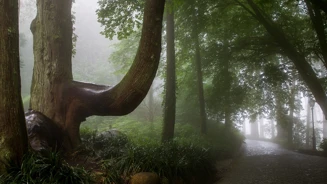Did you know that in the Park of Pena there is a tree that walks?
14 Feb 2024
Nature is predictability unpredictable. We can have very hot days in January and torrential rain in August. We may be surprised by extreme heat phenomena or by devastating storms, like the one that hit the Park of Pena in 2013. The occurrence of such events reminds us that we need to be “vigilant of the devastating consequences they can have, particularly for vulnerable biological and cultural heritage, as is the case with the botanical collection at the Park of Pena, started under the direction of King Fernando II and the Baron of Eschwege in the second half of the 19th century”, argues Elsa Isidro, landscape architect at Parques de Sintra.
An example of this invaluable natural heritage is the Thuja plicata (Giant Cedar) next to the Fountain of the Little Birds. This tree - described by many as 'the Giant of Pena' - was planted at the time of the park's creation, surviving bad weather, heat waves and climate change - it is, therefore, a unique example of the legacy of King Fernando II, the creator of the Park of Pena and its Palace.
In addition to its value in terms of historical memory within the park (and, ultimately, the natural heritage of Portugal), this tree is, in itself, a fascinating object of study. It is 35m tall, has a trunk perimeter of approximately 16.80m and has a notable feature - it appears to be walking.
Yes, you read that right: it looks like it's walking. But how? The answer is simple: the branches tend to develop in a “J” shape and, with the weight of the canopy, they can touch the ground. They then take root, forming a new trunk that moves slightly away from the central trunk. In other words, the tree gradually moves away from the point of origin, as if it were - here it comes - walking slowly. Over the course of 150 years, this tree has taken small but imposing ‘steps’ towards the lake that can be found there.
It's worth visiting, just to see in person what is considered to be the most emblematic and unique tree in the Park of Pena.

